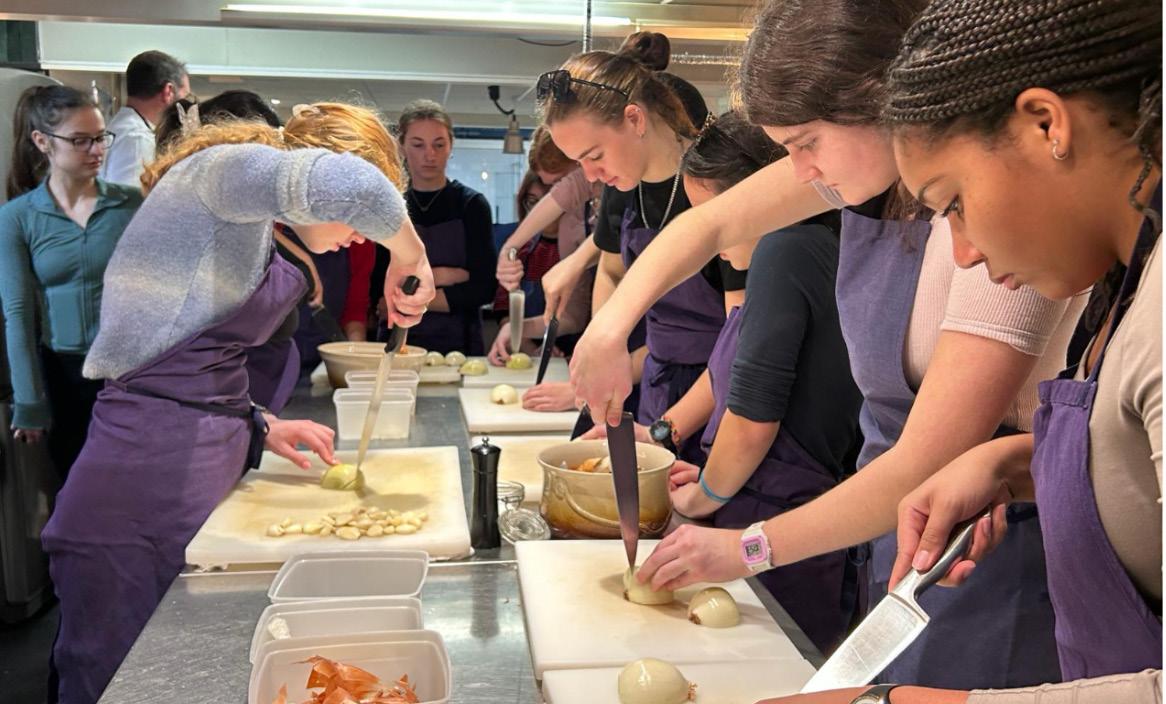
10 minute read
ART & TRAVEL
AIS Global Experience: France Travels to Avignon
By Charlotte Kronholm ’25 Staff Writer
The AIS Global Experience: France class recently traveled to Avignon, France. The trip was filled with beautiful sights, delicious food, and incredible art. The course focuses on “the development of ancient, medieval, and modern cities.” The class not only dove deeply into these concepts in both Avignon and Marseille but also created everlasting memories.
The
Avignon and Marseille was at the heart of the trip. The class participated in a series of engaging activities outdoors – despite the sometimes poor weather – from sketching landmarks throughout the city to hiking through the woods to take in beautiful and ancient sights. While in Marseille the class also joined the Clean My Calanques team (a non-profit organization based in Marseille) and helped pick up trash on the beach of the city.

In addition to the cities’ beautiful sights, the food was another notable experience for the travelers. The class was able to try many different (and delicious) foods while in Avignon. From Pizzerias to amazing Vietnamese food, they learned how food reflects and impacts cultures within a city. The class was even able to learn from a renowned chef in Avignon – Chef Jonathan! The Chef instructed students in the class to make a variety of foods: squash soup, cauliflower cassoulet au gratin, tapenade, and a lavender honey cake. The students then shared their food with local customers at a market, an amazing hands-on experience that provided even more insight into food and culture!

Of course, the investigation into French culture and cultural preservation extended far beyond good food. As Katherine T. recalled in the class’s blog, “I realized that such an important part of culture is art and history.” The class explored photography, architecture, museums, and street art, learning how art and history affect the cities, and the people who live in them.
Participating in a series of classes, having discussions throughout the trip, sightseeing, eating, and visiting museums all provided the class with unforgettable experiences and a plethora of thoughts and ideas about the connections between cities and cultures around the world. The trip ended with a “mini DoL,” memories of new and wonderful experiences and laughter over their final dinner in France. And as Meredith L. stated in the trip’s blog “I learned not only about Avignon, Arles, Aix, Marseille, and Provence as a whole, but also about myself.”
Outside The Bubble
Do the Oscars Understand What the Barbie Movie Was Made For?
By Lauren Hannigan ’25 Staff Writer
The Barbie movie, directed by Greta Gerwig, has been facing an uproar of support and attention from people around the nation. The movie features familiar moments of girlhood and creates a sense of community between a multitude of individuals. It seems as though this support for feminism would be recognized by all people, right? Wrong.
Along with Barbie’s initial success in theaters, the movie was nominated for six Oscars; Best Picture, Best Supporting Actor (Ryan Gosling), Best Supporting Actress (America Ferreira), Best Adapted Screenplay, Best Production Design, and Best Costume Design. However, the Oscars seemingly misunderstood the movie’s true focus, highlighting women’s achievements and abilities. The nominations left both the Barbie movie’s director and leading actress (Barbie herself) out of the picture. As Ryan Gosling (Ken) states best,
“But there is no Ken without Barbie, and there is no Barbie movie without Greta Gerwig and Margot Robbie” (The Washington Post).
Many people believe the recent snub further reaffirms the movie’s patriarchal criticisms, adding to the irony of this year’s Oscar nominations. Others feel this miss is not the fault of the Oscars, but rather the result of the Oscars highlighting other nominees for these categories, such as Emma Stone for Best Female Lead (Lady Bird) and Justine Triet for Best Directing (Anatomy of a Fall). Nonetheless, despite neither Robbie nor Gerwig receiving nominations, America Ferreira’s incredible performance in the Barbie Movie is still being highlighted via her nomination for Best Supporting Actress. The Oscars will be premiering on March 10th, 2024, when all winners will be announced. No matter what, the Barbie movie’s unification of women of all ages will never be forgotten. Stay tuned!
The Grading System is Hurting Grades
By Liv Minnehan ’26 Staff Writer
Miss Porter’s school prides itself on its unique approach to education, including its grading system. Intended to alleviate anxiety and prioritize learning for the sake of learning, this grading system can be beneficial in certain situations, especially when it comes to making formatives and homework less stressful. However, the pros of the grading system are heavily outweighed by the cons. Alphabetical grades are vital when applying to colleges, as they are one of the first and most important criteria viewed on a college application. The highest marks are far too difficult to obtain, between the unrealistic standards and the limited number of assignments that actually contribute to a student’s grade. Students find that it’s incredibly difficult to check and understand the grades that they receive, and GPAs aren’t even given until it’s too late to change them. In an idyllic world, many students would love to abandon traditional grading and enjoy the learning process, but when our future education depends on these numbers, this system only serves to add stress to an already stressful topic.
The impossibly high requirements to get an A only serve to increase students’ anxiety. An Advanced rating directly translates to an A or A+, or a 95 - 100%, and a proficient rating gravitates more towards the B to A- range. Many Porter’s students aspire to go on to top colleges after high school, which expect mostly A to A+. The average GPA of a student admitted into an Ivy League school is a 3.9 on a 4.0 scale. The grading system currently employed at Porter’s seems to set students up to receive mostly proficient ratings with a few advanced ones, which might translate to something more towards 3.5. This is incredibly harmful for students, forcing them to bend over backwards and try to consistently get grades designed to be given out occasionally.
A student’s grade should be a reflection of their performance in a class, not just in final assessments; it should be a combination of all their efforts throughout the trimester. By only considering grades from final assignments, a single mistake in students’ work can have a huge impact on the final score they receive. If a student performs well in class discussions, on homework, and during formative assessments, this is not reflected in their grade. With a traditional grading system, a student can compensate for a shortcoming in one area by putting in extra work in other aspects. By putting all the weight on final assessments, the grading system harms a student’s official performance and surrounds Demonstrations of Learning with anxiety, dread, and other negative emotions. And with the decaying average, finals have much more weight than initial assessments, meaning a single project essentially decides the grade of the entire trimester
Regardless of the efforts to deemphasize the importance of grades, grades are incredibly important while in high school. They are measures of academic aptitude, can act as important motivators, and play a vital role in getting a student into college. Because of this, they also influence many students’ emotions and mental well-being. The grading system aims to fix the effects that grades have without addressing the root issues of the problem. In the end, students, teachers, and administrators all want to see the highest possible performance in school, both academically and emotionally. Is this grading system really the best way to achieve that?
Porter’s Needs to Face The Music
By Zayba Ali ‘25 Staff Writer
The music department at Porter’s faces several significant obstacles that challenge its vitality and impact within the school community. Among these challenges, several recurrent themes emerge, encompassing physical accessibility, scheduling conflicts, and societal stigmas. In dialogue with Patrick Reardon, music director at Porter’s, and students Hannah Satran ‘25 and Finn De Vries ‘24, it becomes evident that these challenges not only impede the department’s operations, but also hinder its ability to thrive and receive recognition.
One of the most pressing issues facing the department is the physical distance of the music building from campus. Some find the steep climb up Mountain Road to be a barrier. Reardon noted this can reduce the visibility of the department.
“The building is undoubtedly far away from all other academic buildings and meeting spaces on campus,” he said. “Quite a few faculty members and students have never been inside the music building. Unless they have taken a class, taken lessons, attended a music lesson workshop or recital, then they may be missing out on seeing it.”
Satran, a member of the choir, agreed. “I had a DOL for the Sarah Porter Singers, and I was telling my friends that they should come. And they’re like, ‘But I don’t want to walk all the way up the hill.’”
In addition to the location challenge, scheduling conflicts often arise when events are planned concurrently with music performances and classes. De Vries spoke to the necessity of prioritizing music classes with the same seriousness afforded to other academic disciplines. “Choir and orchestra are classes, and they need to be taken seriously like any other class,” De Vries said. “Stop expecting that we as students can cut class for meetings.”
Last year, the Dig Pink Volleyball Game was scheduled during the choir and orchestra performances, which significantly detracted from the attendance and support for our musicians.
“It could help if they don’t schedule so many important events on the same nights as music performances,” Satran said. “We do it once a trimester, and there are games every Wednesday and Saturday.”
By implementing a more coordinated approach to event planning and prioritizing the scheduling of music performances, we can ensure that our musicians receive the recognition and audience they deserve.
Perhaps the most concerning issue is the persistent stigma surrounding music at Porter’s. Despite the undeniable talent and dedication of our student musicians, persistent misconceptions perpetuate biases against music as a legitimate pursuit. De Vries and Satran highlighted the derogatory attitudes towards “music kids,” reflecting a broader reluctance to embrace the arts within the school community. “I feel like there’s a stigma around it. … I feel like people are very against the idea of music here,” Satran said. It is time to challenge these misconceptions and recognize the immense value that music brings to our community.
The challenges facing the music department at Porter’s are multifaceted but not insurmountable. Even in the past few years, the department has made strides toward improvement. “My sophomore year, there was one trimester where there were four people in choir,” De Vries said. Today, the music program includes roughly one-third of the school population in some capacity, according to Reardon. Through collaborative efforts and a commitment to change, we can cultivate a culture where the arts are celebrated and valued. How can we do this? In the words of Satran, “If there’s a music performance and you can go, go. Just suck it up and walk up the hill.”





